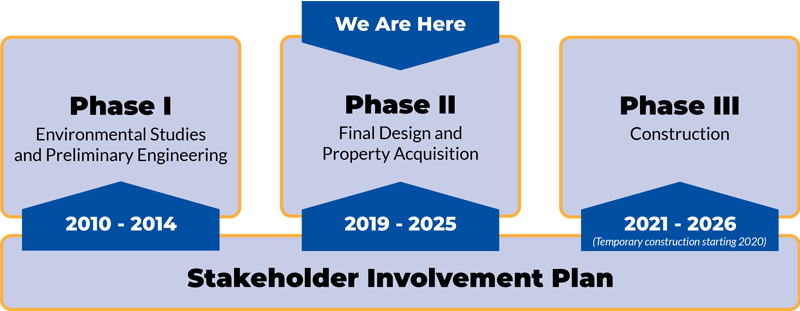About the 75th St. CIP
Project Phases
The 75th Street Corridor Improvement Project (75th St. CIP) is the largest project in the Chicago Region Environmental and Transportation Efficiency (CREATE) Program. The project is located in the Chicago neighborhoods of Ashburn, Englewood, Auburn Gresham and West Chatham along two passenger and four freight rail lines.
Phase I
The first step in the 75th St. CIP development process began with a Phase I (Environmental Impact Study (Opens in a new window) and Preliminary Engineering feasibility study), which took a broad-brush look at the scope and purpose for the project, determining whether it could be accomplished in a reasonable manner. Feasibility studies examine the economic, social and environmental impacts of the proposed project to determine regional benefits. The feasibility study develops a statement of the preliminary "purpose and need" for the project.
Next, environmental impact studies were prepared to identify important community resources and evaluate how the 75th St. CIP improvements being studied would benefit or effect those community resources, as well as investigate right of-way requirements. Right-of-way is the land acquired for a transportation route. The environmental study also included an evaluation of measures to avoid, minimize or mitigate impacts of the project on the surrounding communities. Parallel to environmental studies are preliminary engineering studies. Preliminary engineering studies are initiated to determine the benefit or effect of the transportation improvements being studied. The feasibility, environmental and preliminary engineering studies are collectively referred to as Phase I.
Phase II
Once design approval is obtained and funding is secured, the preparation of the final design, including contract plans can begin. This process is generally known as Phase II. Phase II includes the production of plans, specifications and estimates (PS&E's) for the actual contract documents from which each project will be constructed. Many projects also require the acquisition of property, including the 75th St. CIP. This is done concurrently with the final design. Any necessary property acquisition will follow the federal Uniform Relocation Assistance and Real Property Acquisition Policies Act of 1970 and the Illinois Department of Transportation Land Acquisition Manual. This will ensure:
- Owners are fairly compensated for the value of their property
- Renters and owners receive relocation assistance, including moving expenses
- Other costs associated with comparable replacement housing are covered
- Residents are given the opportunity to relocate within the community, if possible
Below is a summary of the work that is funded.
Design and Construction of Forest Hill Flyover (P3)
The Forest Hill Flyover (P3) consists of a new CSX north-south rail flyover structure to eliminate conflicts between north-south and east-west train movements at Forest Hill Junction (75th Street and Western Avenue). The final design (Phase II) began in 2019 and was completed in 2022. Temporary construction (Phase III) began at the end of 2020 and is anticipated to conclude in 2023.
Design and Construction of 71st Street Grade Separation (GS19)
The 71st Street Grade Separation (GS19) consists of a road-rail grade separation of 71st Street and the railroad tracks near Bell Avenue. The design (Phase II) work began in 2019 and was completed in 2022, and construction (Phase III) is anticipated to start in 2022.
Design of Belt Junction and 80th Street Junction Replacements (EW2)
The Belt Junction and 80th Street Junction Replacements (EW2) will reconfigure the east-west tracks at Forest Hill Junction (75th Street and Western Avenue), add tracks to remove the bottleneck at Belt Junction (near 75th Street and Loomis Avenue), realign track and signal systems between Belt Junction and the Dan Ryan (Interstate 94) Expressway, reconstruct 80th Street Junction (near 80th Street and Wallace Street), relocate Union Pacific tracks to a currently unused Norfolk Southern alignment, and add positive train control (PTC) along this stretch of tracks. EW2 also includes a new Metra mainline track and improvements to several existing viaducts over city streets. The final design (Phase II) work began in 2020 and is expected to be completed in 2025.
Design of Rock Island Connection (P2)
The Rock Island Connection (P2) will build a flyover structure to connect the Metra SouthWest Service (SWS) mainline tracks to the Rock Island Line. The final design (Phase II) work began in 2020 and is expected be completed in 2025. CREATE Program partners are seeking construction (Phase III) funding for this project. The rail improvements will relocate all SWS trains to the LaSalle Street Station and increase passenger rail capacity at Union Station.
Phase III
Once the final design, land acquisition, and the securing of funding have taken place, a project can advance to Phase III.
Construction of Forest Hill Flyover (P3)
Final construction of the Forest Hill Flyover (P3) project began in 2022 and is planned to be completed in 2025.
Construction of 71st Street Grade Separation (GS19)
Final construction of the 71st St. Grade Separation (GS19) project began in 2022 and is planned to be completed in 2025.
CREATE Program partners are currently securing funding for Phase III of the Rock Island Connection (P2) and Belt Junction and 80th St. Junction Replacements (EW2) projects.



